Inari Sushi is a traditional sushi of vinegared rice tucked inside sweet and salty deep-fried tofu pockets. Known as Inarizushi in Japan, they are one of the easiest types of sushi to make at home and are beloved by children and adults alike. This vegetarian- and vegan-friendly sushi is perfect for a snack, a picnic lunch, or as part of your sushi dinner platter.
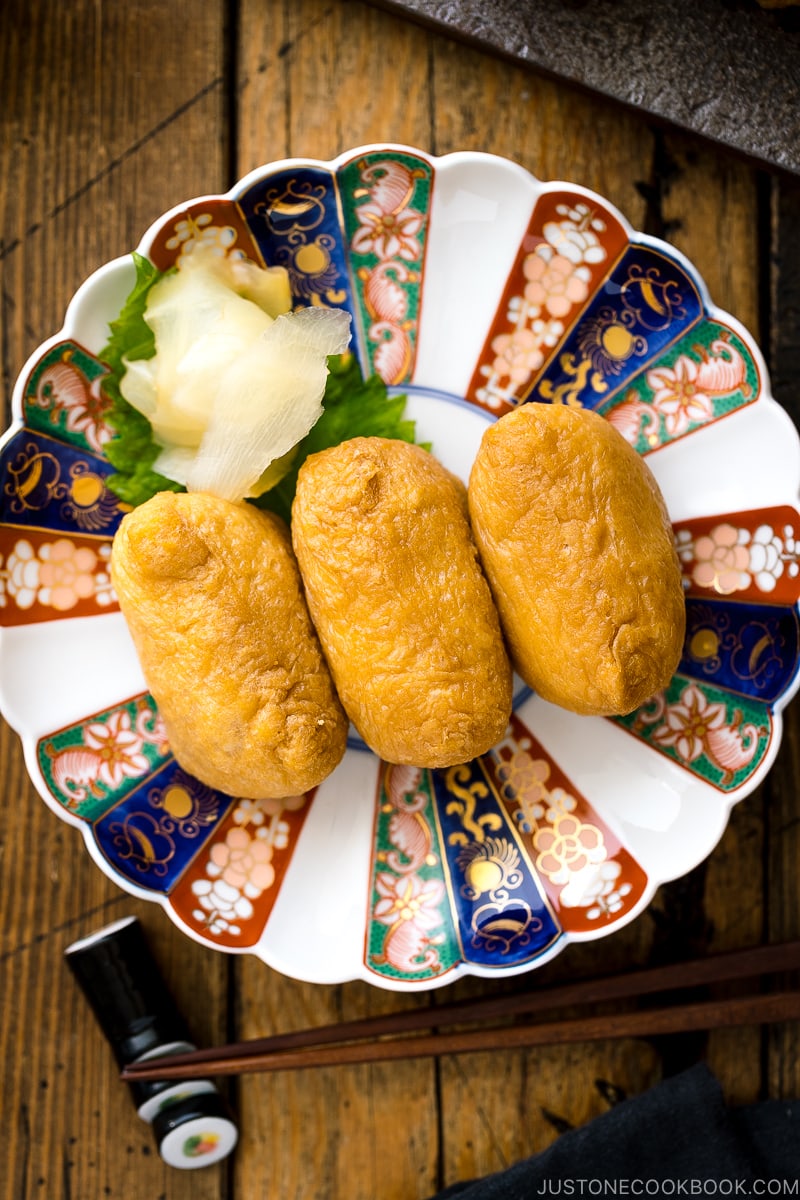
Looking for an easy sushi recipe to make at home? You won’t go wrong with Inari sushi (稲荷寿司). You can enjoy tasty, filling, and addicting Inari sushi at any time of the day. They make a satisfying little snack and the perfect finger food to serve at your next home gathering. In this recipe, I’ll show you how to make proper sushi rice and two variations of Inari sushi.
Table of Contents
What Is Inari Sushi?
Inari sushi (稲荷寿司, いなり寿司), or Inarizushi as we call it in Japan, are made of sushi rice that we stuff inside seasoned deep-fried tofu pockets/pouches called Inari age. The tofu pockets are cooked in a dashi-based broth. After the tofu pockets absorb all the flavors, we squeeze them to remove the liquid and get them ready to stuff with sushi rice.
With their sweet and savory taste and toothsome bite, these little golden pockets are the best sushi to enjoy at home, picnic, or on the go. Inari sushi are also a popular item for bento boxes, and you may see this type of sushi packed at the deli along with sushi rolls.
The Origin of Inari Sushi
Behind its popularity, Inari sushi has a fascinating story. It gets its name “Inari” directly from the deity who protects the crops. At Inari shrines in Japan, people bring the deep-fried tofu pockets–what we call aburaage (油揚げ)–as offerings and place them in front of the fox statues on the shrine grounds.
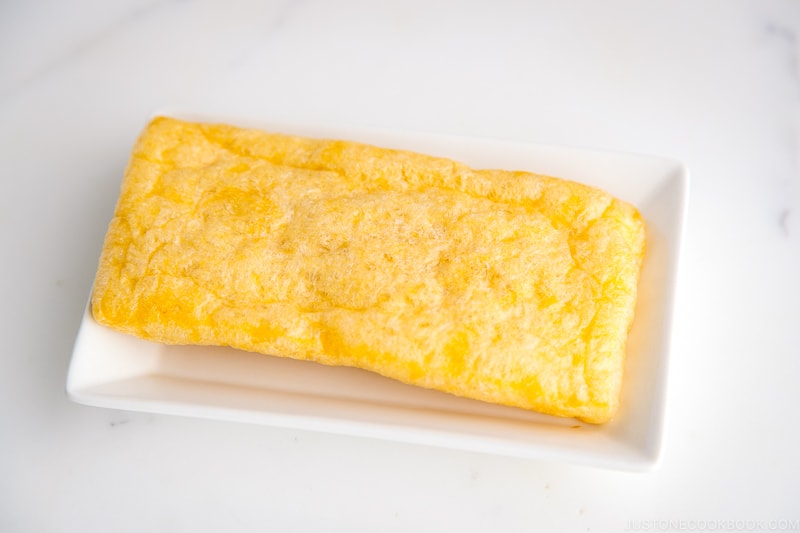
It is said that foxes are the messengers of the Inari god and it’s believed that they like aburaage. Eventually, newly harvested rice was added as a filling to the fried tofu pockets to show gratitude for good crops towards the Inari god.
Hence, the dish was named Inarizushi or Oinari-san (O is an honorific prefix, and -san is an honorific title) and the Japanese have enjoyed it for over 170 years.
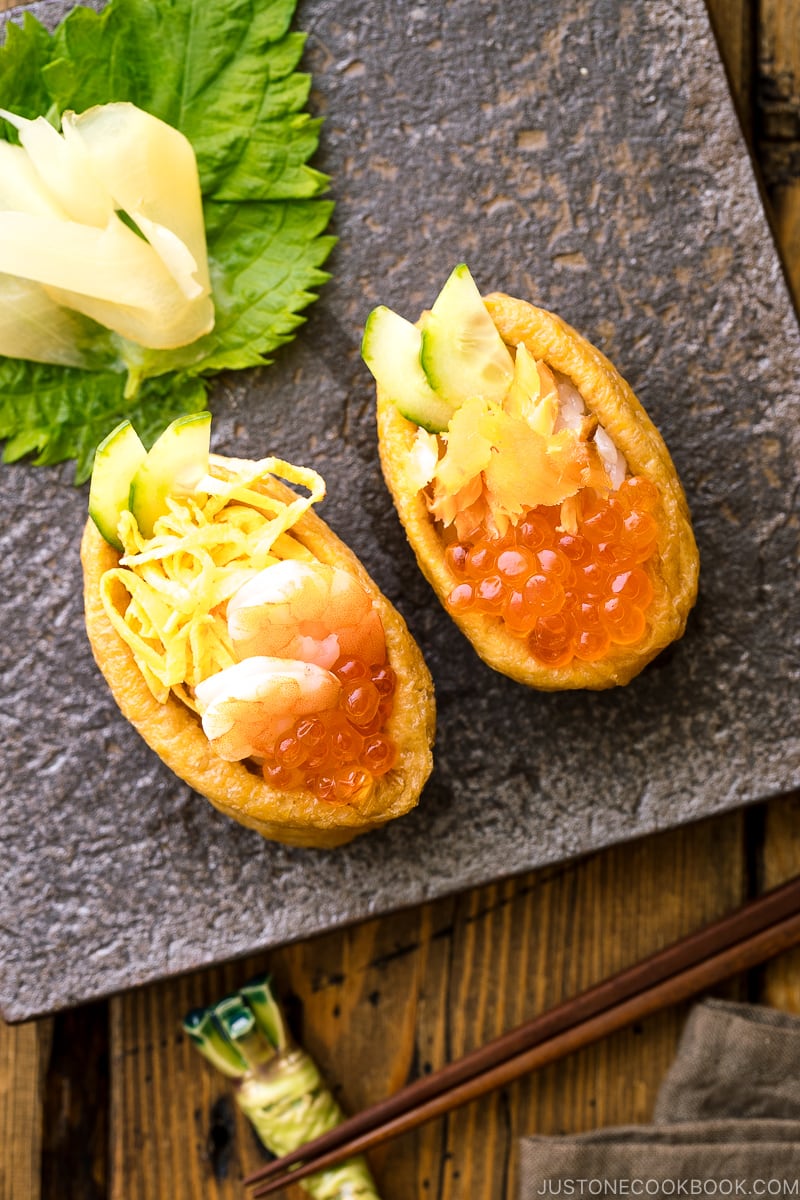
Tokyo vs. Osaka Style Inari Sushi
In Japan, Inari sushi in the Tokyo area and the ones in the Osaka area are actually different in shape. In the Tokyo area, Inari sushi is shaped like a straw bag and the sushi rice is completely wrapped inside.
Whereas in the Osaka area, you will find fox-ear-like triangle-shaped Inari sushi that exposes the sushi rice at the bottom. Other versions include straw bag-shaped Inari sushi that is decorated with colorful ingredients on the top opening. Sometimes sushi rice inside the tofu pocket is mixed with various ingredients to give additional flavors and texture.
Tokyo-Style Inari Sushi
- Straw bag-shaped
- Sushi rice is completely covered in Inari age
Osaka-Style Inari Sushi
- Triangle-shaped (sushi rice is exposed on the bottom)
- Straw bag-shaped (opening on the top, decorated with colorful ingredients)
- Sushi rice is mixed with ingredients like Osaka-style chirashi sushi
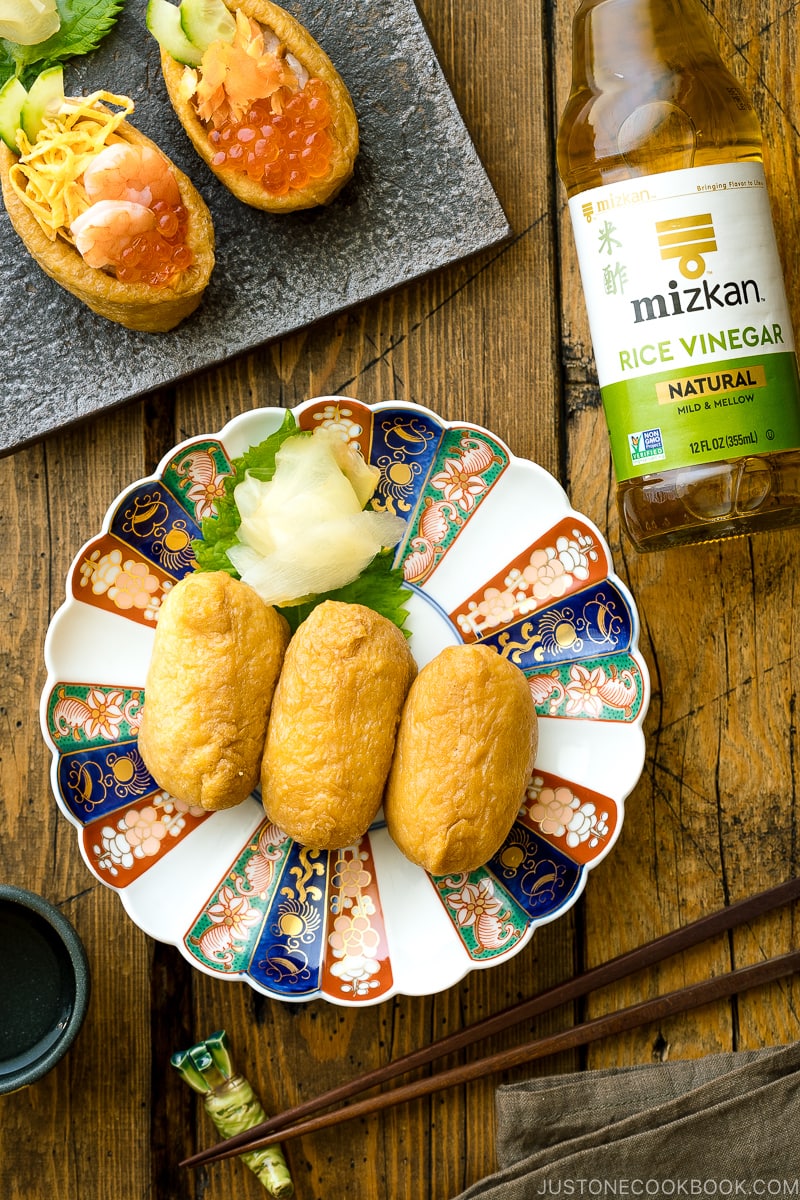
How to Make Inari Sushi
Inari sushi is made in three simple and easy steps.
- Make homemade Inari age* by simmering tofu pockets in sweet and savory dashi-based broth. Or, buy packaged Inari age from a store.
- Make sushi rice. Cook rice with kombu (dried kelp) and season the cooked rice with sushi vinegar.
- Stuff the sushi rice into the tofu pockets.
It all comes together very quickly once you make the sushi rice.
*If you have an extra hour, I recommend making homemade Inari age. You can even make it in advance and freeze it!
Homemade vs. Store-Bought Inari Age
Homemade Inari age are the best, in my opinion, especially because store-bought ones tend to be a lot sweeter. However, there are benefits for store-bought Inari age. Let’s compare the two.
Homemade Inari Age:
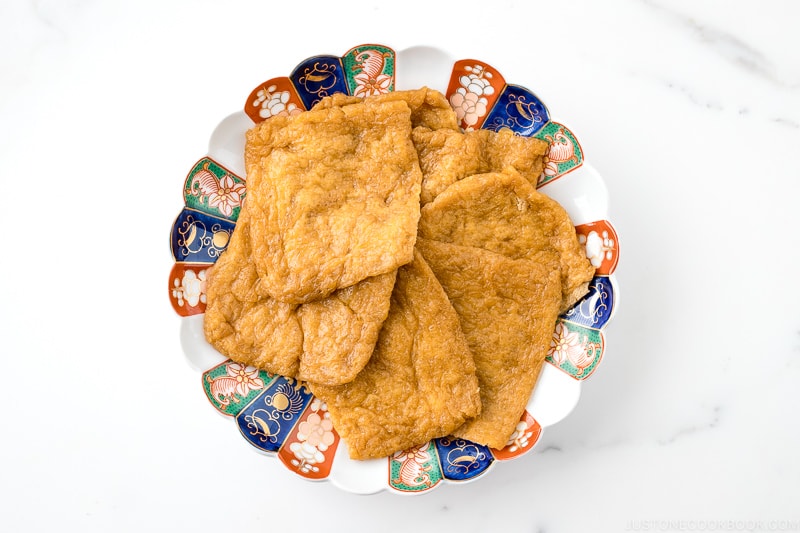
- Natural ingredients and no preservatives.
- You can adjust the seasonings – less soy sauce, less sugar, etc.
- Vegetarian/vegan-friendly with the use of kombu dashi.
Store-bought Inari Age:
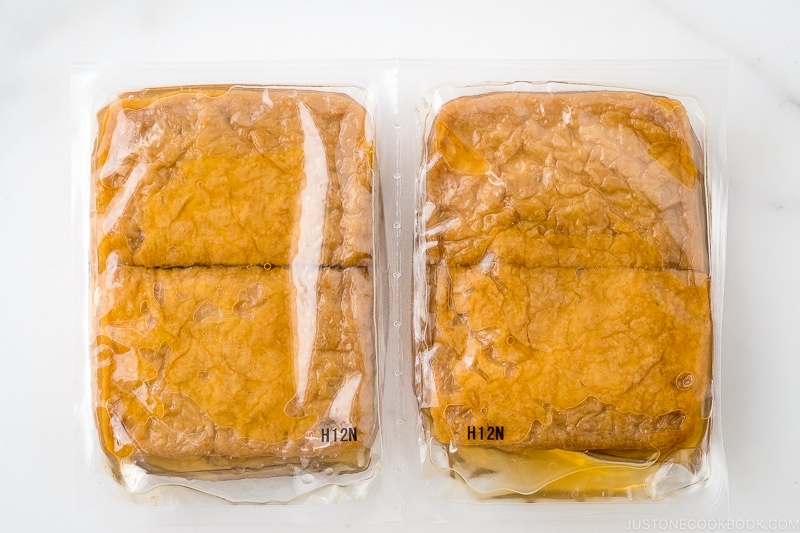
- To make homemade Inari age, you’ll need deep-fried tofu pouches, but they can be hard to find. According to JOC readers around the world, ready-made Inari age are more accessible at their local Japanese/Chinese/Korean grocery stores.
- Shorten cooking time for Inari sushi by roughly one hour.
When I have time, I make my own Inari age; otherwise, I use the store-bought Inari age for Inari sushi or kitsune udon. When I make homemade Inari age, I make sure to double or triple my recipe and freeze them for later use.
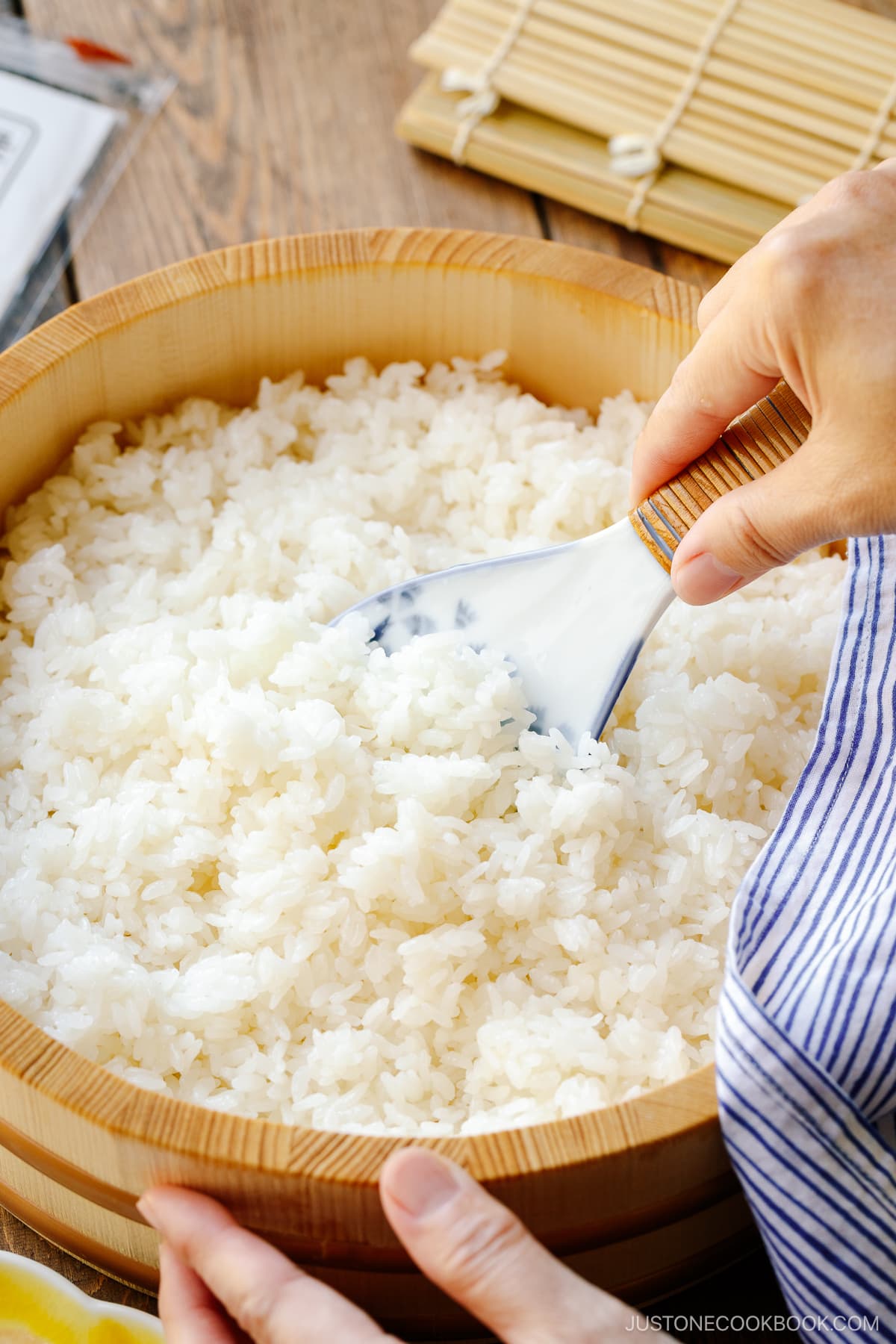
How to Make Delicious Sushi Rice
When we say “sushi rice” in Japan, it always means the seasoned steamed rice that we use to make all kinds of sushi. We never use unseasoned regular steamed rice to make sushi.
Sushi rice (sumeshi 酢飯) is made with short-grain rice cooked in kombu-steeped water and then seasoned with sushi vinegar.
Sushi vinegar (sushizu 寿司酢) is made with just three ingredients—rice vinegar, sugar, and salt. It gives the rice a beautiful shine and delicious flavor, perfect for all kinds of sushi. You can find my detailed technique for preparing sushi rice in the recipe card.
I can’t emphasize enough that it’s important to use rice vinegar, not other types of vinegar you may have in the pantry. Rice vinegar is a lot milder than the other kinds of vinegar. For convenience, I also keep a bottle of sushi vinegar at home when I need to make sushi rice in a pinch. Sweet, mild, and versatile, Mizkan Seasoned Rice Vinegar is my go-to sushi vinegar to accent many Japanese dishes!
Inari Sushi Cooking Tips
When Making Sushi Rice
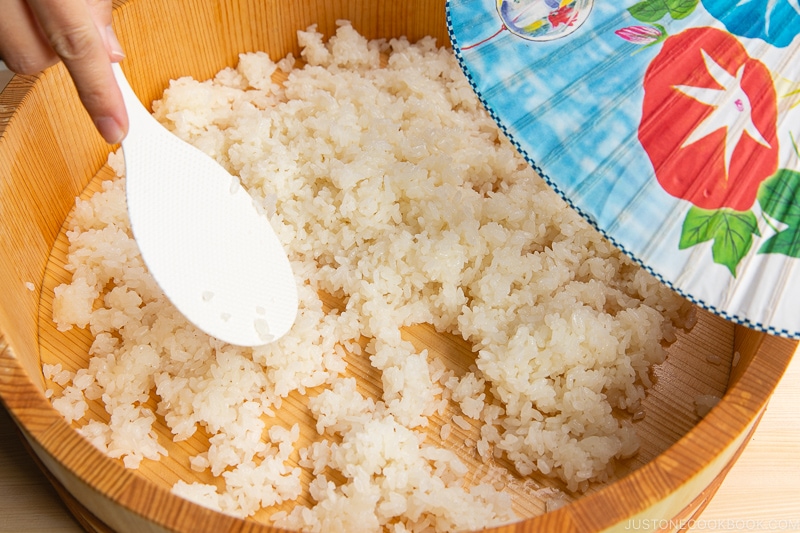
- Use only Japanese short-grain rice. Do not use any other type of rice as it won’t be sticky enough and will fall apart easily. Read more here.
- Make sure to use rice vinegar, not other kinds of vinegar.
- Use a large bowl (I use a sushi oke or hangiri here) or a baking sheet to cool and season the cooked rice.
- “Slice” the rice, instead of mixing the rice, so the rice will not get mushy.
- Fan the cooked rice to cool it, which gives a beautiful shine to the rice!
When Stuffing Sushi Rice
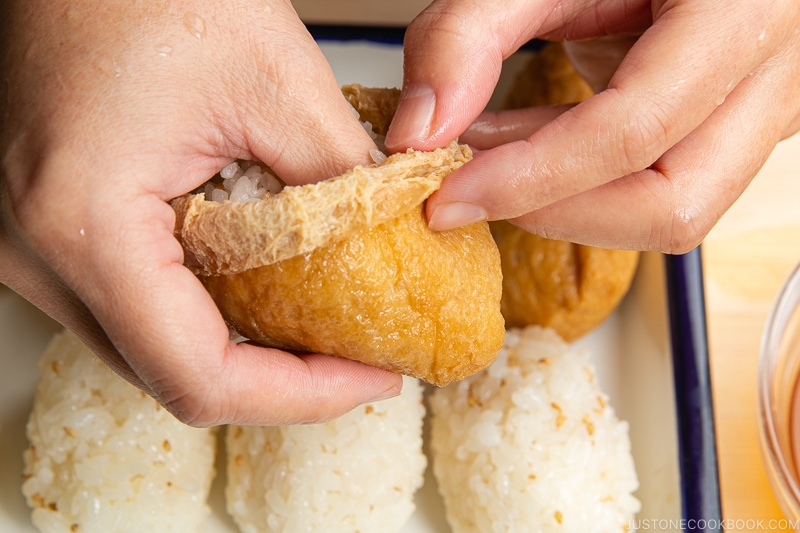
- Carefully open the tofu pockets. They are so fragile, so take your time as you open the pockets.
- Don’t stuff too much rice. Start with a small amount. You can always add more.
- Stuff the rice into two corners. This is very important to achieve the perfect round corners.
- For Osaka-style Inari sushi, flip upside down and show the rice. Tuck in the edge of the Inari age inside the bag, so it will have a round smooth edge. You can decorate the top with shredded egg crepe called kinshi tamago, ikura, cooked shrimp, cucumber slices, or any toppings you like!
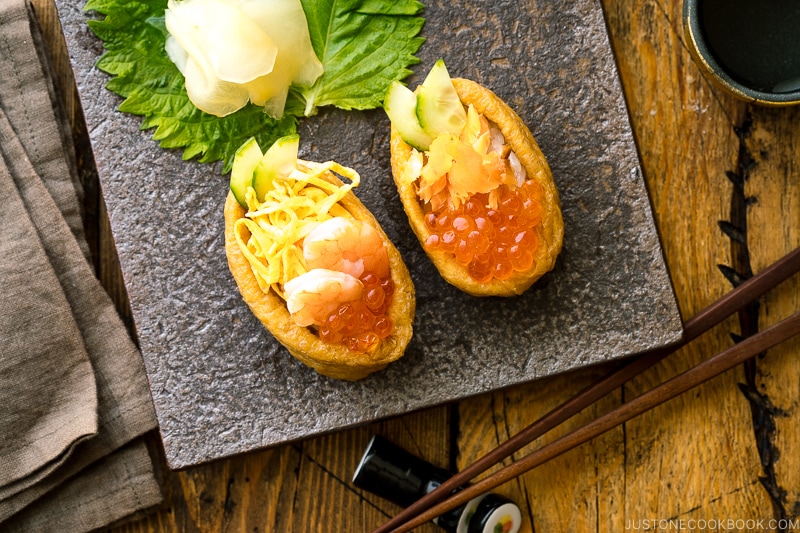
The Perfect Sushi to Enjoy Anytime
For those who enjoy cooking with your kids, you want to give Inari sushi a try! Together, you can stuff the sushi rice into the tofu pockets. It’s super fun and ridiculously easy.
I love packing Inari sushi in a bento box with some vegetables for a simple quick lunch. For dinner, you can serve Inari sushi with futomaki, hosomaki, or temaki sushi (hand roll sushi) as part of your sushi meal. They make the perfect afternoon snack too!
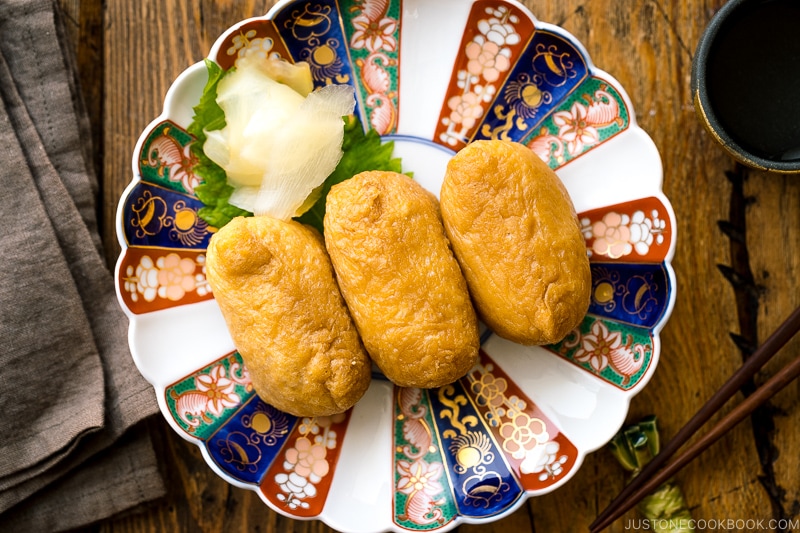
Wish to learn more about Japanese cooking? Sign up for our free newsletter to receive cooking tips & recipe updates! And stay in touch with me on Facebook, Pinterest, YouTube, and Instagram.
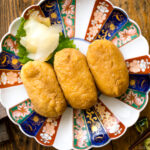
Inari Sushi
Ingredients
For the Sushi Rice
- 1½ cups uncooked Japanese short-grain white rice (2 rice cooker cups)
- 1½ cups water (1-to-1 ratio of rice to water)
- 1 piece kombu (dried kelp) (5 g, 2 x 2 inches, 5 x 5 cm per piece; optional, but it gives a nice aroma)
- 4 Tbsp rice vinegar (unseasoned) (I used Mizkan Natural Rice Vinegar; if you use Mizkan Seasoned Rice Vinegar, skip the sugar and salt below)
- 2 Tbsp sugar
- 1 tsp Diamond Crystal kosher salt
For the Inari Sushi
- 12 Inari age (seasoned fried tofu pouch) (store bought; reserve the liquid left in the package; or you can make Homemade Inari Age)
- 1 Tbsp toasted white sesame seeds
For the Garnish
- sushi ginger (gari)
- 5 shiso leaves
Instructions
- Before You Start: The rice cooking time is 45 minutes to 1 hour, depending on the method you use.
- Please note that 1½ cups (2 rice cooker cups, 300 g, 10.6 oz) of uncooked Japanese short-grain rice yield 3½ cups (660 g) of steamed rice, enough for 12 Inari sushi pieces. You must use Japanese rice or your sushi will fall apart. The rice-to-water ratio for sushi rice is 1 to 1; we cook the rice on the firm side, since we later add more liquid with the sushi vinegar. Now, gather all the ingredients.
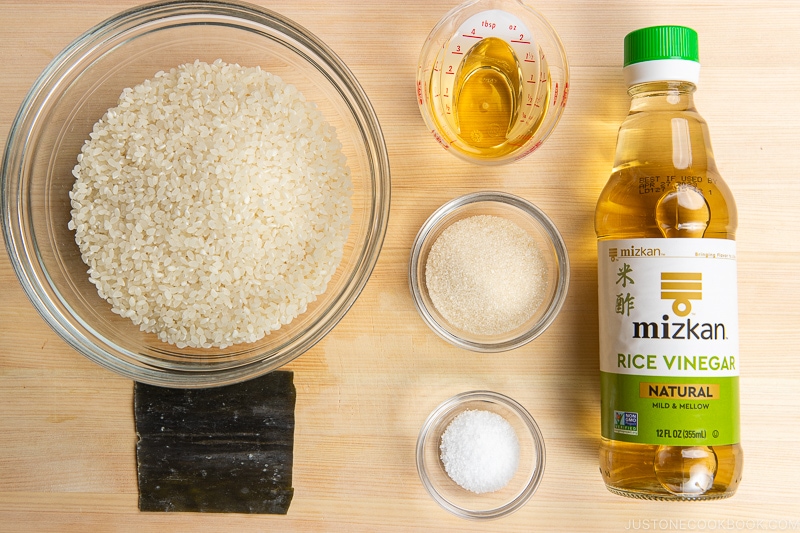
To Cook the Rice
- Wash and Rinse: Place 1½ cups uncooked Japanese short-grain white rice in a bowl. Quick rinse the rice by adding just enough water to submerge all of it, then pour off the water immediately; repeat once more. To wash it, gently agitate the wet grains with your fingers in a circular motion for 10–15 seconds. To rinse it, add water and immediately discard the cloudy water; rinse once more. Repeat the wash and rinse steps two more times. Finally, drain the rice very well in a fine-mesh sieve and shake off any excess water.
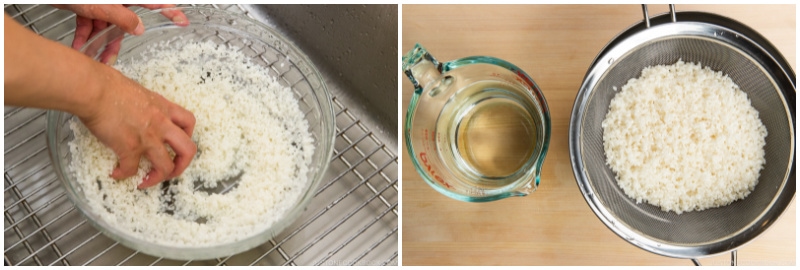
- Cook: Put the well-drained rice in the inner pot of your rice cooker. Add 1½ cups water (just below the water line for 2 rice cooker cups of uncooked rice). If your rice cooker has a Sushi Rice mode, add water up to that line. Next, check 1 piece kombu (dried kelp) and wipe off any dirt particles with a damp cloth, but keep the white powdery umami substance. Place the kombu on top of the rice and let them soak in the water for 20–30 minutes. Then, start cooking. You can also cook the rice in a pot on the stove or Instant Pot with the water measurement I specified in this recipe.
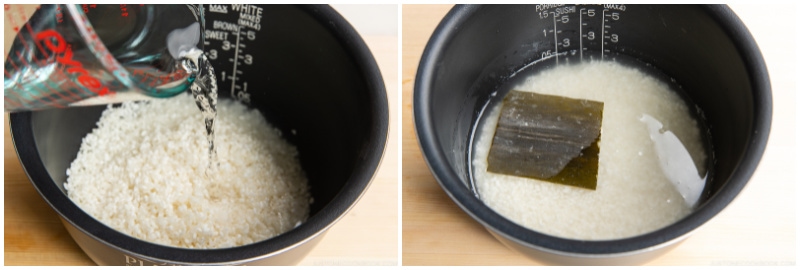
To Season the Sushi Rice
- While the rice is cooking, make the sushi vinegar. Combine 4 Tbsp rice vinegar (unseasoned), 2 Tbsp sugar, and 1 tsp Diamond Crystal kosher salt in a small bowl. Microwave it for 30–40 seconds and whisk until the sugar is completely dissolved. Alternatively, you can put it in a saucepan and bring it to a boil over medium-high heat and whisk to dissolve the sugar. Set it aside and cool to lukewarm or room temperature.
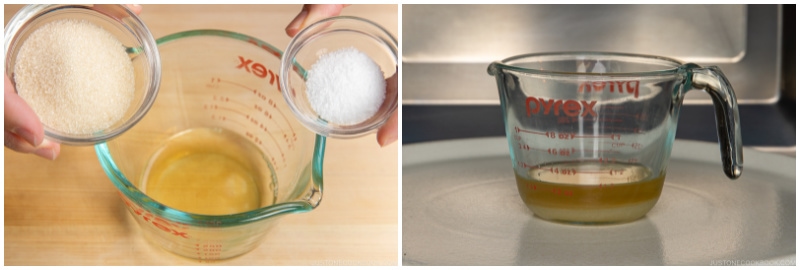
- If using a wooden sushi oke (also called hangiri), moisten it with running water and drain well. You can also use a baking sheet lined with parchment paper. When the rice is cooked, discard the used kombu (or repurpose it to make simmered kombu) and transfer the hot cooked rice into the sushi oke.
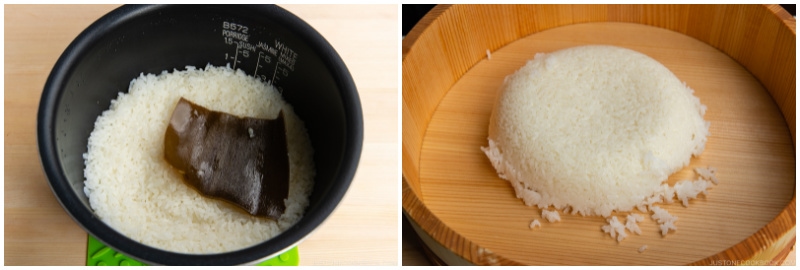
- Evenly spread out the steaming hot rice, then slowly drizzle the sushi vinegar all over it. Gently “slice” the rice with a rice paddle at a 45-degree angle to distribute the seasoning and break up the rice chunks. Do not stir or mix it because the grains may break and get mushy. At the same time, vigorously fan the rice with a paddle fan or other fan to cool it and remove excess moisture. Fanning also makes the rice shine and keeps it from getting mushy. Gently flip the rice in between slices. Slice and fan until the rice is cooled to the temperature of human skin. Then, cover it with a damp towel (or paper towel) and keep for up to a few hours at room temperature.
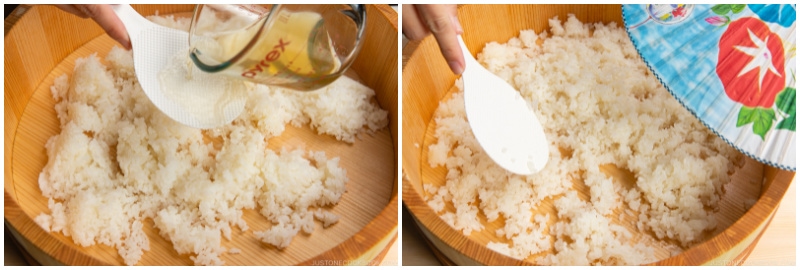
To Make the Inari Sushi
- Now, let’s make the Inari sushi! Take out 12 Inari age (seasoned fried tofu pouch) from the refrigerator.
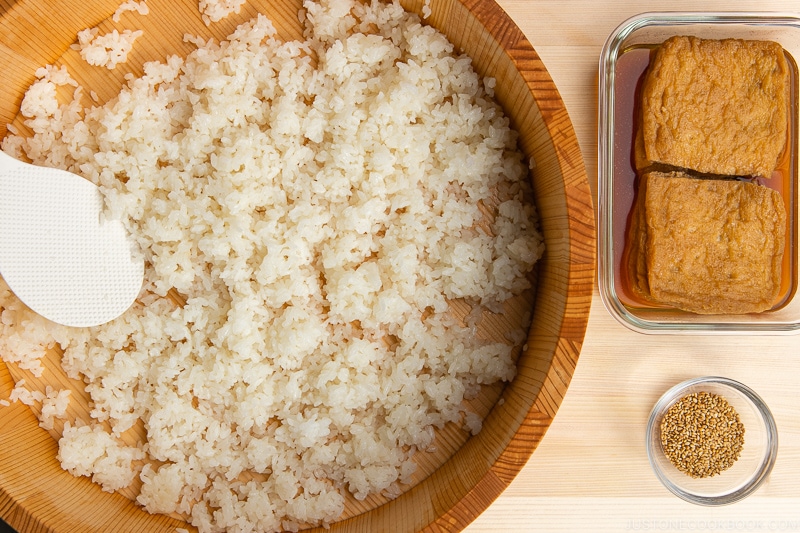
- Sprinkle 1 Tbsp toasted white sesame seeds over the sushi rice and gently “slice” the rice again to combine. Next, divide the sushi rice into quarters; you’ll make three Inari Sushi pieces with each quarter of sushi rice.
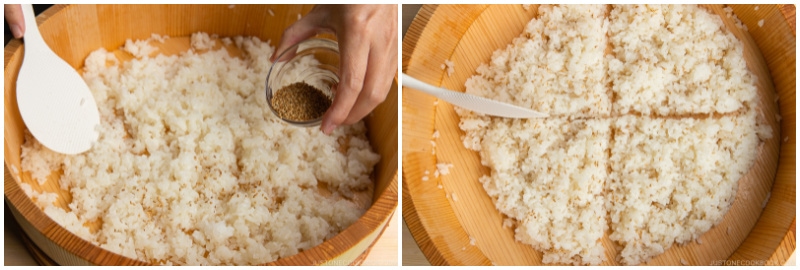
- Pour the seasoning/cooking liquid from the seasoned Inari age package into a small bowl. Moisten your hands with this seasoned liquid and place a small handful of sushi rice (about ¼ cup) in your palm.
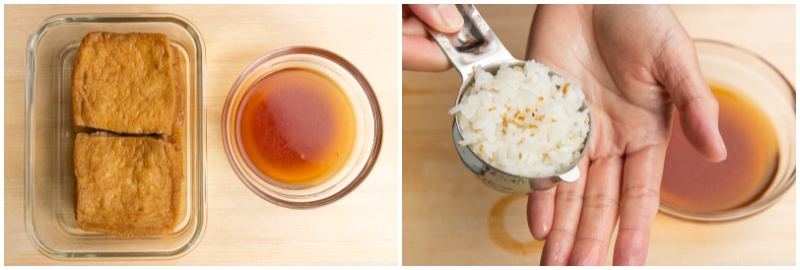
- Gently form the sushi rice into an oblong shape. Your hands should be just firm enough so the sushi rice doesn’t fall apart. Try to keep the density of the sushi ball as airy as possible and don't squeeze the rice too tightly. Repeat with the rest of sushi rice. You should be able to make 12 sushi rice balls.
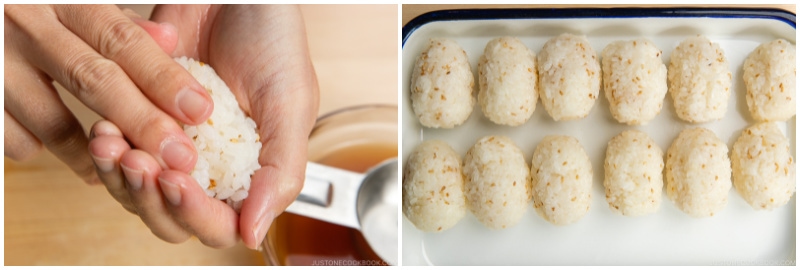
- Squeeze out the seasoned Inari age and carefully open the Inari age pockets, separating the skin all the way to the bottom of the pocket. Be gentle, as the skin is thin. Then, fold back the skin at the opening.
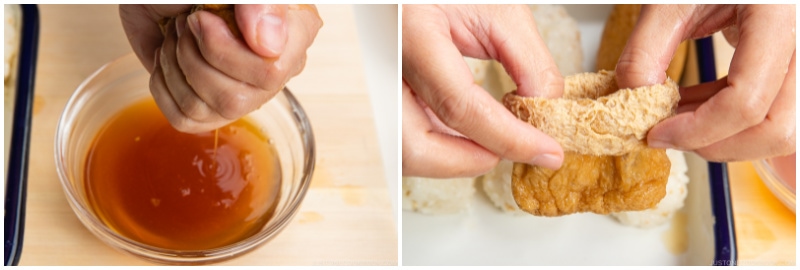
- Stuff each sushi rice ball into the Inari age pockets. Stuff the rice all the way into the pocket so that the two pocket corners look smooth and round.
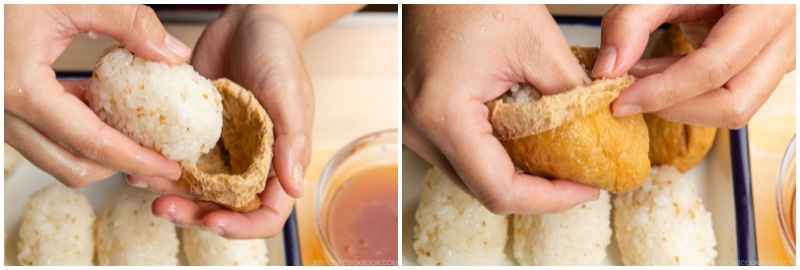
- Finally, close the Inari sushi: Unroll the skin at the opening, then fold both side edges down onto the sushi rice ball.
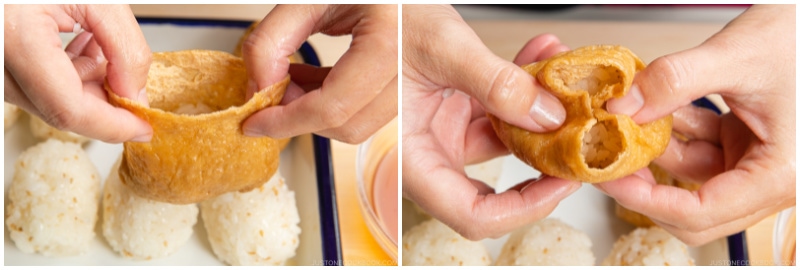
- Then, fold the front and back edges down like you’re wrapping a present. Place the sealed Inari Sushi seam side down onto a plate or tray. Continue with the rest of the pockets. Your Inari Sushi are now ready to serve.
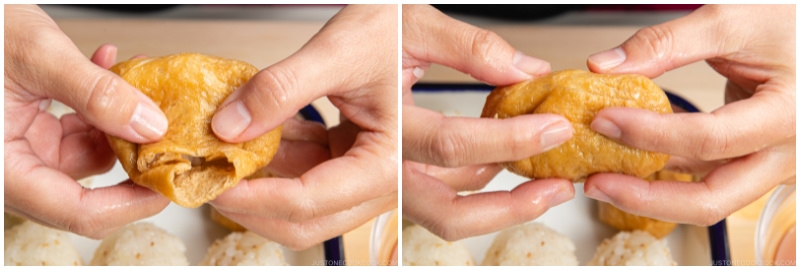
To Make Kansai-Style Inari Sushi (optional)
- To make Kansai-style Inari Sushi (optional), decorate the top with colorful ingredients. After stuffing the pocket with sushi rice, keep it open on top and tuck the edges of the Inari age inside the pocket so you will have smooth, round edges. Then, add any toppings you like. Here, I used sliced cucumber, ikura (salmon roe), shredded egg crepe (kinshi tamago), boiled shrimp, and cooked salmon flakes.

To Serve
- Serve the Inari Sushi at room temperature. Garnish with 5 shiso leaves and sushi ginger (gari), as desired.

To Store
- Please consume the Inari Sushi the same day they’re prepared. You can keep them in a cool place for several hours. You can also store leftovers in the refrigerator for up to 24 hours. I highly recommend transferring them to an airtight container or a plate wrapped tightly with plastic, then wrapping it completely with a thick kitchen towel. The towel insulates the rice from the cold air so the rice doesn‘t get hard and dry. Store leftover Inari age pouches with their liquid in the freezer for up to a month or in the refrigerator for 2–3 days.
Nutrition
Editor’s Note: The post was originally published on February 28, 2011. It’s been updated with new images and revised blog content in December 2021.
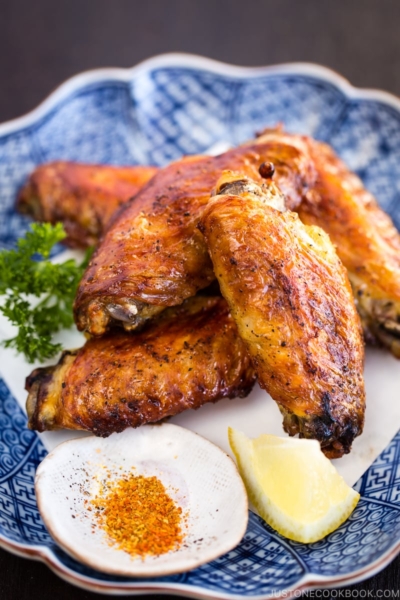
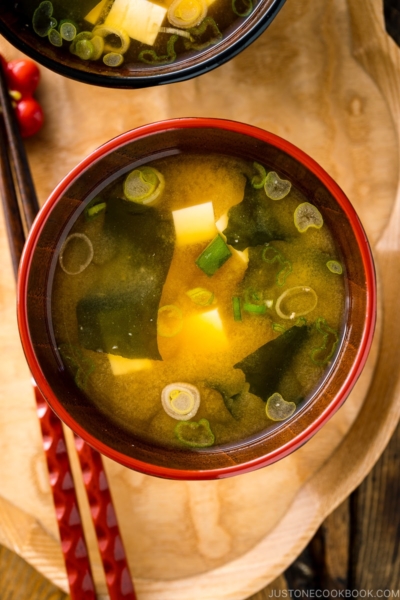
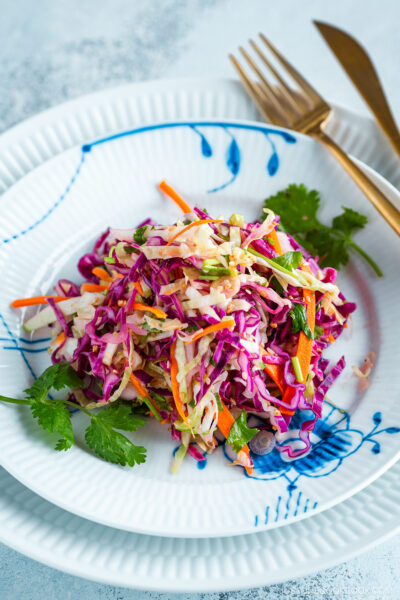






Hi Nami! I love Justonecookbook. Please keep up your fabulous work. I sometimes make Inarizushi by adding minced cooked carrots and hijiki to the seasoned rice. We all love it!
Hello, Marianne. Thank you very much for your warm remarks to Nami.
We are delighted to hear you enjoy Just One Cookbook! 🥰
Thank you for your love and support, as well as for sharing your cooking experience with us. Happy cooking!
I love this stuff, but there’s something I want to double check. I’ve made this recipe several times and every time the rice has a very very strong vinegar taste, which I really like, but I want to make sure – is it supposed to be like that? The one time I was able to find a Japanese restaurant that serves it, it tasted like regular sushi rice – much more subtle vinegar taste.
Hello, Jack! Thank you so much for trying Nami’s recipe!
Each region in Japan will have a slightly different flavor of sushi rice. Some may even make it even sweeter or vinegarier.
So, feel free to adjust the sweetness to your liking.
We hope this was helpful!
Aloha Nami, I love Inarizushi – In Hawaii we grew up making and eating lots of it.. every day anyday and lots at parties …We have it in bento plate style in our convenient stores (like 7/11 ) people for lunch will grab inari and then also manapua (which is chinese bao breads steamed and filled with char siu meats n now adays EVERYTHING even curry) .. It’s everywhere lunch wagons u name it.. But Inarizushi we call it here Inari or Cone sushi (ours is usually is vinegar sushi rice – grated carrots sesame seeds n I know we put something else in it but can’t remember I gotta look thru old recipes like ebi shrimp but ah I forgot lol usually I didn’t make it with that other ingredient ) – I had it both styles well 3 styles ….one fully wrapped basket style , the basket open and then the triangular which is bigger we usually got the premade ones in cans… For parties we usually made the maki rolls (black nori) sushi cuz its less expensive when feeding larger crowds ….for those Hawaiian style they use tuna (can kine) mixed with a lil shoyu (soy sauce) with brown sugar mixed in and carrots parched precooked jus a lil (sometimes in rice vinegar/sugar , eggs beaten n cut into strips and dried green/red ebi shrimp for color.. when you are making hundreds the black nori style is used .. I rolled so many sushi in my lifetime lol and still rollin’ along..But inari cone sushi I have memories of making that with my mom (who passed in 2019) for us making it at home it was a more jus for us lol da secret stash sushi …. lol I love ya website great job on not only giving us your recipes but for sharing the history traditions and such behind each one – That’s what makes it taste even better the cultural meanings behind it.. Its like ancestors that pass on is with you in the making…
Konnichiwa Lynn, Thank you so much for taking the time to read Nami’s post and share your Inari story with us.
It’s great to hear about different Inari styles, and we learn a lot from readers like you.
We appreciate your comments, love, and support. Happy Cooking!🤗💞
Inarizushi is one of my son’s and my favorite types of sushi. A Japanese-American friend of my late mother taught us to make them over 40 years ago. We affectionately “gunny sacks”. I like them with tiny green peas mixed into the rice. As with so many kinds of sushi, I would like to top them with salmon roe. I have hunted, but only found them at Whole Foods in very, very tiny jars, and very expensive, but with a horrible odor and flavor. Any suggestions where I can find some in South Florida or online without spending a full month’s Social Security check?
Hi, Lorraine! Thank you for reading Nami’s post and sharing your favorite type.
The best place to find a good salmon row is at a local Japanese or Asian store.
We’ve compiled a list of stores recommended by our readers for purchasing Japanese items, and we hope it helps you in your search.
https://www.justonecookbook.com/japanese-grocery-stores-around-the-world/
And this is the online store that we recommend. https://catalinaop.com/eggs-caviar/
We hope this helps!
Perfect for a special occasion that you don’t want to spend too much money on. These scrumptious pouches of delciousness take some effort to put together, but they are well worth it! Bonus points if you have helpers who will get into stuffing them with you. Just make sure they wash their hands 😉
Hi John! 😆 Yes!
Thank you for sharing your thought and reminding everyone to wash their hands before making Inari Sushi! 😊🤩
I tried making this today and was very pleased with the outcome, such a good description of how to deal with the sticky rice. The only problem I had were the pouches, they had to be cut open and that was a very delicate job that took longer than expected. Are they always like that? I thought they come ready to be filled.
Hi Sylke! Thank you for reading Nami’s post and trying her recipe!
We are so happy to hear Nami’s instructions were very helpful.😊
The store-bought Inari Age usually comes ready to be filled. However, it may be different depending on the brand.
When my son was in Yochien, I tried to make inarizushi for his obento. After school, his teacher took me aside and gently told me that you have to mash the rice together firmly in a ball before you put it in the abura age. He took a bite and rice went all over him.
We have an Inari shrine in our town and many shops sell variations. My favorite has chunks of walnuts mixed into the rice. Yummy!
Hi Jeanne! Thank you for reading Nami’s post and sharing your story!
We are sure now you are the expert on how to make Inari Sushi.🤗
Mixed Walnuts Inari Sushi sounds very Yummy too. We will try.☺️
I love inari sushi! I have seen inari age in a can but have not tried. Can you or your readers comment on flavor compared to inari age found in the refrigerator case?
Hi Susan! Thank you very much for reading Nami’s post!
The canned Inari age is also good. To me, it is just a bit sweeter than refrigerator ones.
We hope this helps!
These are so tasty! I made some Inarizushi and then some Kitsune udon with the leftover inariage. However, I have some etiquette questions – is Inarizushi typically eaten with hands or with chopsticks? And are you supposed to eat it in a single bite?
Hi Aster! We are glad to hear you enjoyed Inari dishes!
Typically, we use chopsticks, but you can use chopsticks or hands to eat. We usually eat Inari Sushi in a few bites, not a single bite.😉
Thank you very much for trying Nami’s recipe!
This is my favorite sushi, and the one I most commonly ate as a child, for oshogatsu and picnics. Give me this, anyday, over sushi with raw fish! Thank you, Nami.
Hi Susan! Thank you very much for reading Nami’s post!
We hope you enjoy making Inari Sushi this Oshogatsu!🎍
My favourite! Grandma always made these on New Years Eve. I miss the giant sushi platters during the holidays. Just not the same without grandma. 🥰
Hi Liv! We are glad to hear Inari Sushi is your favorite! Thank you very much for reading Nami’s post!
We hope Nami’s instructions help to make Inari Sushi that is close to your grandma’s.🙂
Great article and recipe! As a twist, try cutting in minced ginger and Yuzu to the sushi rice.
Hi Craig! Thank you very much for reading Nami’s post and sharing your cooking experience!